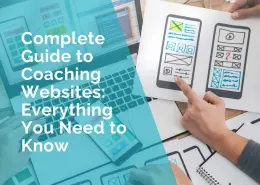How Do I Get My Business on the Internet?
This is one of the most frequently asked questions by small business owners. They are feeling the pressure from their customers and competitors, yet for many business people it is a daunting task, as they don’t understand the whole process.
In fact, many people are even asking the question whether they should have a website. Whether you are a consultant, florist, designer, builder, architect or a doctor, consider the many advantages a website provides:
1. Make money – Set up an on-line store or get paid for advertising from other companies
2. Save money on advertising – Instead of paying for large ads, simply advertise your website
3. Be flexible in your message – Change the content as your business changes. No need to re-print expensive brochures.
4. Exposure to new customers – You will reach more local clients as well as interstate and global markets
5. Having more professional image – Keep up with the times and your competitors
6. Save time – Don’t spend hours on the phone, direct customers to your website
7. Keep your business open 24/7 – Provide customers information when THEY need it. If you don’t, someone else will.
So what does it really take to get your website set up?
Step 1 – Register your domain name OR not.
The big question is whether you need to register a domain name or not. The simple answer is NO, but a better answer is YES it is a good idea.
What is a domain name?
The purpose of a domain name is similar to that of a street address or telephone number. The domain name directs customers to you on the Internet. The domain by itself is not your email or web address. The domain does form the base from which these addresses are derived.
For example:
Company Name: QikPhone
Domain Name: qikphone.com.au
Web Address: www.qikphone.com.au
Email Address: sales@qikphone.com
Do I need to register a domain name to have a website?
NO, you don’t need to have your own domain name. Your website can be created and hosted without it. Your website address will look something like this: www.web4business.com.au/JBCleaning OR www.ozemail.com.au/~JBCleaning
The only advantage of not registering a domain name is that you will save yourself a few dollars per year.
The disadvantages of NOT having your domain name include:
1. If you decide to change your Webhosting company or if that company goes out of business, you will lose your website address. Your website can be transferred to a new company, but your address will change. And that means re-printing stationery and re-doing all your advertising, notifying all your customers etc.
2. Website addresses that contain information other than your company name are long and hard to remember and do not appear as professional. Compare these two and see which one you are more likely to remember: www.ozemail.com.au/~JBCleaning OR www.JBCleaning.com.au
So it is a good idea to register a domain name, even if it is just to protect yourself for the future. Say for example, your business name is JB Cleaning and you decide not to register your domain name for now. Along comes Joe Bloggs who opens his own cleaning business and registers JBCleaning.com.au domain name. After a year you decide you want to have your own domain name, but since Joe Bloggs already owns it, you won’t be able to register it. Not to mention your customers who know your business as JB Cleaning may visit his website, thinking it’s your web address and instead hire Joe Bloggs Cleaning.
Step 2 – Plan your website.
Planning your website is a two part process:
(a) Decide on the website design (colour schemes, buttons, special effects etc). This is your website designer’s job. However, you may have a preference for a certain colour or look. To help you choose a design, you may wish to check out other people’s websites or work with your web designer’s pre-set templates.
(b) The content. There are many items you may wish to include on your website. The most common ones include:
1 Product/Service Details
2. Contact Information
3. Pricing
4. Testimonials
5. Frequently Asked Questions
6. Response Form, such as “Join Mailing List”
7. On-line Magazine or Newsletter
8. Resources & Articles
9. Guarantee
10. Survey
11. Events Calender
12. Search My Website Form
13. Refund Policy
14. Privacy Policy
15. About Us Information
16. Site Map
17. Copyright information
18. Useful Links
19. Media Information
20. On-line store
21. News
22. Directions to Your Bricks & Mortar Premises
Step 3 – Choose a Web Hosting Company.
What is a Web hosting Company?
A Web host is a company that provides server space for your website. You can think of a web host as a commercial building. The web host provides space for your website just as a commercial building provides space for your shop or office. You can build your own building and you can host your own website, but because of the cost and expertise required it is easier to rent the space.
Which Company Should I Choose?
Web hosting companies are not created equal so you need to take a number of things into account when selecting one. A proven track record, experience and reliability form the foundation of any successful business partnership.
Some of the issues you should consider when choosing a webhosting company include:
1. Support – Does it provide comprehensive Technical Support – 24 hours a day, seven days a week?
2. Reliability – Does it have multiple large-scale links to the internet to provide a fail-safe path to your customers from anywhere in the world?
3. Security – Does it have a robust security system that minimises risk of web site intrusion?
4. State-of-the-art – Does the company utilises leading edge technology and is supported by a large-scale uninterruptible power supply (UPS) system.
5. Scalability – Does the product range and services offered allow your business to grow without impediment by making it easy to upgrade and add components to existing product levels.
Step 4 – Getting people to your site.
The marketing of your website is important if you want to draw visitors to your site. If you don’t promote your website no-one will ever see it. There are a number of different ways of advertising your website. The best strategy is one, which integrates your existing promotion methods with your website.
1. Office Stationery – Including your web address and email address on your stationery is probably the easiest way to draw attention to your site. It’s cost effective and gets your Internet presence out there in the market place.
2. Business Cards – When printing business cards you should include the individual’s email address and main address of your website.
3. Radio Advertising – Radio Advertising should include your web address. Don’t include the http://, try “Visit us on the internet at w-w-w-dot-qikphone-dot-com-dot-au”. If your budget is limited, you may wish to consider community radios.
4. Email and Mail-Outs – Let your current customers know the details of your website. You can either send them an email or a letter/postcard. Keep your website’s content up-to-date and they will keep coming back!
5. Print Media – Print advertising should include a generic email address for the company and include your website address. Normally positioned at the bottom right or bottom centre of your advertisement.
6. Search Engines & Directories – People looking for your website who don’t know the URL are most likely to use an on-line search engine to look for your organisation or the kind of products and services you offer. There are over 300 major search engines and directories, but you should concentrate on the larger, more commonly used ones. These include: Google, Yahoo, Altavista, Anzwers, Inktomi, Infoseek, Lycos, Excite, HotBot, MSN, Dogpile, AllTheWeb etc.
7. Links from other websites – A good way to attract visitors to your site is through the use of hyperlinks placed on other sites. If you know of another site which has a list of links and you think your website would be a good addition, let the website owner know. You might also offer to provide a link from your site back to the other site. This will encourage the webmaster to include your site. You should also seek out partners for trading links including vendors, suppliers and providers of complimentary products.
8. Link Exchange – Another way to getting a link is through a system called Link Exchange, a free public service designed to help websites advertise each other. With Link Exchange, you agree to display advertising banners for other Link Exchange members and they agree to display banners for you. The System is automatic, you simply add a piece of HTML code to your web page and Link Exchange will display an advertisement for another website. The disadvantage with Link Exchange is that you don’t get any control as to where your banner ad appears or the type of banner ads that will appear on your website. It is not possible to guarantee that a competitor of yours may have their banner ad displayed on your site.
9. Paid Banner Advertising/Affiliate Marketing Programs – Various sites give you the opportunity to purchase banner advertising on their site. Some sites will charge you a flat monthly fee while other sites will charge you based on the number of people who see your ad.
For more information about marketing your website read “30 ways to promote your website on a shoestring budget”
Step 5 – Monitor your site’s statistics
Your website’s statistics should show who visits your website, where in the world they come from, how they are finding your site and what pages are being viewed. Knowing your customers is the first step in effective marketing. Most webhosting companies will provide access to this information free of charge.
Step 6 – Maintaining your website
It is important to update your website regularly to keep your customers interested. One of the great advantages of having a website is that you can change its content virtually overnight at minimal cost (unlike re-printing brochures and flyers).
This is just a brief overview of the process involved in getting your website up and running. In future articles we will cover each step in more detail.
You may also wish to check out:
Frequently Asked Questions About Websites
10 Tips for Planning an Outstanding Website
8 Tips for Designing a Great Website
*****
by Ivana Katz
 Websites 4 Small Business – www.web4business.com.au;
Websites 4 Small Business – www.web4business.com.au;
Ivana makes it easy for you to get your business online very quickly. If you’re looking for a professional and affordable website designer, CLICK HERE and download your FREE copy of “Ultimate Website Design Secrets Blackbook – 10 Bulletproof Strategies for Designing an Outrageously Successful Website”














